The Upsurge of Beauty Virtual Try-Ons
Convenient and practical or detrimental to retail stores?
Fifty years ago, the idea that someone could order clothes on a computer and have them delivered the very next day would have been inconceivable. An intriguing dream in a parallel society, but, alas, impossible. Fast forward 50 years, and this is a daily reality. The rise of the online fashion industry is disrupting and damaging brick-and-mortar clothing stores worldwide.
While this is a new reality facing the fashion industry, not many predicted a similar dilemma for the beauty industry. How could one perfectly match a foundation shade or test eyeshadow pigments from home? Many people crave to feel cosmetics products and test them on their skin before taking the financial plunge. As beauty companies are currently seeing rapid success using virtual try-on technology, physical beauty stores could face the same fate as the fashion industry.
To those who never anticipated that it was possible to test out makeup products at home while wearing flannel pajamas with a rerun of How I Met Your Mother blaring on the TV screen, it’s time to think again. The escalating trend of virtual try-ons allows consumers to test out various products— from shimmery eyeshadow shades, blushing rouges, to even hair color— right in front of their phone screen, wherever they are. All consumers have to do is place their face in front of the camera. Then the magic starts.
Some of the top beauty empires, Ulta Beauty and Sephora, have implemented this feature on their mobile apps. Potentially the best attribute to virtual try-ons is time convenience. Not only can beauty enthusiasts avoid traffic while racing to get their hands on a lipstick that just dropped, but virtual try-ons make it possible to apply or remove products with just a touch of a button. One minute a deep forest green can be painted on the eyelids, then tap! Now the eyelids resemble a soft summer sunset. Besides this thrilling aspect, the one-time use of makeup wipes and cotton balls in retail stores will significantly reduce–much to the appreciation of the environment!
While virtual try-ons have been around for a few years, the popularity in the beauty industry rose dramatically when the COVID-19 pandemic hit. This is due to the national shutdown in Spring 2020, the strict sanitary mandates in stores, and the fact that many consumers would prefer to stay home to protect themselves and others from the virus. Allure explains how L’Oreal Paris has seen an increase in traffic to their virtual try-on features since the start of the pandemic, according to Vivianna Blanch, Vice President of Integrated Consumer Communications at L’Oreal Paris.
Furthermore, Forbes states that Ulta Beauty attributes its increase in customer loyalty in 2020 to features they emphasized when COVID-19 hit, including virtual try-ons.
Though many people immerse in the convenience of utilizing these apps from home, Ulta Beauty and Sephora also offer the virtual try-on feature in-stores. Since physical testers are out of the question due to the pandemic, virtual try-ons serve as an eco-friendly and safe alternative that allows consumers to experiment with new products.
Will beauty brick-and-mortar stores suffer due to the rise of virtual try-on technology? There is no real confirmation of when life will get “back to normal.” Until then, virtual try-ons offer a way to sample beauty products safely. Over time, consumers may become accustomed to these features, and the shopping experience for cosmetics could drastically change. This new convenience may be too tempting to forgo when the pandemic ceases. Beauty companies will need to accommodate new consumer demands and potentially revamp the shopping experience as a whole.
Companies will undoubtedly continue to enhance their virtual try-on features and update them as technology advances. Could holographic makeup applications or 3D printing cosmetics products become a reality? It could be headed that route. However, there will always be consumers that prefer to shop in-store for cosmetics. To some, nothing compares to physically trying on and feeling products, no matter how advanced technology becomes.
Brick-and-mortar beauty stores may not be facing the same danger clothing stores currently do, but there is no fortune-telling of what will happen in the future. Just as the fashion industry exhibited, what happens in 50 years may not even be in the realm of current thought.









